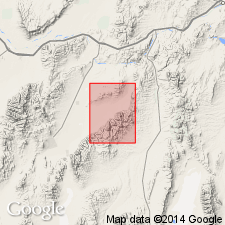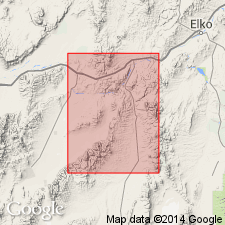
- Usage in publication:
-
- Sod House Tuff*
- Modifications:
-
- Named
- Dominant lithology:
-
- Tuff
- AAPG geologic province:
-
- Great Basin province
Summary:
Named for Sod House Creek which drains part of extensive area of poor outcrops of formation. Type section designated in Pony Trail Canyon, Frenchie Creek and Pine Valley 15' quads, Eureka Co, NV. Consists predominantly of altered white silicic ash-flow tuff. Thickness at type is 300 ft, 0 to 1000 ft range. Appears to pinch out to southwest and thin abruptly northeastward from Big Pole Creek. Locally unconformably overlies Big Pole Formation; underlies Frenchie Creek Rhyolite (both new and in Pony Trail Group). Cut by Lower Cretaceous(?) plutons. Assigned Mesozoic age.
Source: GNU records (USGS DDS-6; Menlo GNULEX).

- Usage in publication:
-
- Sod House Tuff*
- Modifications:
-
- Age modified
- AAPG geologic province:
-
- Great Basin province
Summary:
Frenchie Creek Rhyolite of Pony Trail Group is considered Late Jurassic on basis of 151 +/-3 Ma age on biotite (R.L. Armstrong, written commun., 1972). All three formations in group, Big Pole Formation, Sod House Tuff, and Frenchie Creek Rhyolite, are now considered Jurassic and probably Late(?) Jurassic.
Source: GNU records (USGS DDS-6; Menlo GNULEX).
For more information, please contact Nancy Stamm, Geologic Names Committee Secretary.
Asterisk (*) indicates published by U.S. Geological Survey authors.
"No current usage" (†) implies that a name has been abandoned or has fallen into disuse. Former usage and, if known, replacement name given in parentheses ( ).
Slash (/) indicates name conflicts with nomenclatural guidelines (CSN, 1933; ACSN, 1961, 1970; NACSN, 1983, 2005, 2021). May be explained within brackets ([ ]).

